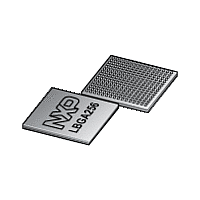LPC1850FET256 NXP Semiconductors, LPC1850FET256 Datasheet - Page 126

LPC1850FET256
Manufacturer Part Number
LPC1850FET256
Description
The LPC1850FET256 is a high-performance, cost-effective Cortex-M3 microcontroller featuring 200 kB of SRAM, and advanced peripherals including Ethernet, High Speed USB 2
Manufacturer
NXP Semiconductors
Datasheet
1.LPC1810FBD144.pdf
(157 pages)
Available stocks
Company
Part Number
Manufacturer
Quantity
Price
Company:
Part Number:
LPC1850FET256
Manufacturer:
NXP
Quantity:
1 000
Part Number:
LPC1850FET256
Manufacturer:
NXP/恩智浦
Quantity:
20 000
Company:
Part Number:
LPC1850FET256,551
Manufacturer:
NXP Semiconductors
Quantity:
10 000
Part Number:
LPC1850FET256,551
Manufacturer:
NXP/恩智浦
Quantity:
20 000
NXP Semiconductors
Table 29.
LPC1850_30_20_10
Preliminary data sheet
External
pin
LCD_VD0
LCD_LP
LCD_ENAB
/LCDM
LCD_FP
LCD_DCLK P4_7
LCD_LE
LCD_PWR
GP_CLKIN
LCD panel connections for TFT panels
TFT 12 bit (4:4:4
mode)
LPC18xx
pin used
-
P7_6
P4_6
P4_5
P7_0
P7_7
PF_4
13.2 Crystal oscillator
The crystal oscillator is controlled by the XTAL_OSC_CTRL register in the CGU (see
LPC18xx user manual).
The crystal oscillator operates at frequencies of 1 MHz to 25 MHz. This frequency can be
boosted to a higher frequency, up to the maximum CPU operating frequency, by the PLL.
The oscillator can operate in one of two modes: slave mode and oscillation mode.
Table 30.
Fundamental oscillation
frequency
2 MHz
4 MHz
8 MHz
•
•
LCD
function
-
LCDLP
LCDENAB/
LCDM
LCDFP
LCDDCLK
LCDLE
LCDPWR
LCDCLKIN PF_4
In slave mode the input clock signal should be coupled by means of a capacitor of
100 pF (C
in this configuration can be left unconnected.
External components and models used in oscillation mode are shown in
and in
only a crystal and the capacitances C
case of fundamental mode oscillation (the fundamental frequency is represented by L,
C
and should not be larger than 7 pF. Parameters F
crystal manufacturer.
L
and R
Table 30
Recommended values for C
components parameters) low frequency mode
S
TFT 16 bit (5:6:5 mode)
LPC18xx
pin used
-
P7_6
P4_6
P4_5
P4_7
P7_0
P7_7
). Capacitance C
C
All information provided in this document is subject to legal disclaimers.
in
Figure
and
Rev. 3.1 — 15 December 2011
Table
37), with an amplitude of at least 200 mV (RMS). The XTAL2 pin
LCD
function
-
LCDLP
LCDENAB/
LCDM
LCDFP
LCDDCLK
LCDLE
LCDPWR
LCDCLKIN
31. Since the feedback resistance is integrated on chip,
P
in
Maximum crystal series
resistance R
< 200
< 200
< 200
< 200
< 200
< 200
< 200
< 200
Figure 38
X1/X2
TFT 16 bit (1:5:5:5 mode) TFT 24 bit
LPC18xx pin
used
-
P7_6
P4_6
P4_5
P4_7
P7_0
P7_7
PF_4
X1
in oscillation mode (crystal and external
and C
represents the parallel package capacitance
S
32-bit ARM Cortex-M3 microcontroller
X2
LPC1850/30/20/10
need to be connected externally in
LCD
function
-
LCDLP
LCDENAB/
LCDM
LCDFP
LCDDCLK
LCDLE
LCDPWR
LCDCLKIN PF_4
C
, C
L
, R
S
and C
External load capacitors
C
33 pF, 33 pF
39 pF, 39 pF
56 pF, 56 pF
18 pF, 18 pF
39 pF, 39 pF
56 pF, 56 pF
18 pF, 18 pF
39 pF, 39 pF
X1
LPC18xx
pin used
P4_1
P7_6
P4_6
P4_5
P4_7
P7_0
P7_7
, C
P
X2
are supplied by the
© NXP B.V. 2011. All rights reserved.
LCD
function
RED0
LCDLP
LCDENAB/
LCDM
LCDFP
LCDDCLK
LCDLE
LCDPWR
LCDCLKIN
Figure
126 of 157
38,















